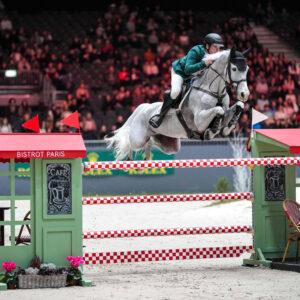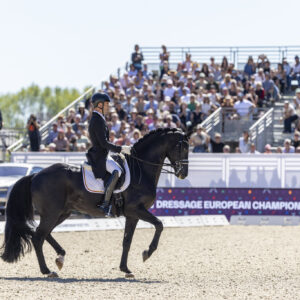#MasterclassMonday is a collaboration between Horse Network and NOELLEFLOYD.com to empower equestrians. Every Monday we’ll bring you a new lesson from a leading trainer to help you troubleshoot your training, master your mindset and up your game. This month’s featured rider: Ian Millar.
Any imbalance in a horse is going to imbalance the rider and vice versa, the balance of the rider will affect the balance of the horse.
I learned balance on the longe line. When I was about 12 years old, I was a working student for a dressage rider in Edmonton, Alberta. He was an older gentleman, classically trained in Germany, and he was a great believer in longeing as a training tool.
This trainer put me on his horses nearly every day without stirrups or reins, and he’d have me sit facing the front, facing the back, juggling tennis balls, and doing various exercises. Through this experience, I became very balanced and at home on a horse.
Want more? Ian Millar’s new Equestrian Masterclass teaches body control and feel.
All these years later, we still use those same exercises with our students. It’s very common that we longe our students without reins and stirrups to emphasize their balance and help them understand how their bodies interact with their horses.
Like all things in horse training, you do it incrementally. You start with a really good, safe horse. You keep your stirrups at the beginning. You keep your reins. Eventually, you’re comfortable enough to tie a knot in your reins and lay them down on the neck and ride with your elbows crossed or your hands on your hips or behind your back. In due course, you’re comfortable enough to drop your stirrups and pretty soon you’re just sitting up there at the walk, trot, and canter relying strictly on balance and feel.
Once a rider reaches that stage, we’ll apply the same skillset to jumping. When we’re training riders and horses to do gymnastics, we’ll get to the point where they can tie a knot in their reins, let the reins lay on the neck, cross their arms across their chest, and away they’ll go down through the gymnastic. They cannot use the reins at all for any form of balance.
This helps with riding on course, too. It also helps keep a rider safe. If a horse decides to rear, for example, and you need to lean forward quickly to stay in balance rather than get caught back and risk falling out the back door, your balance will instinctively react and correct. If a horse goes to stop at a jump and you’re balanced, you’ll instinctively come back to center. You typically don’t come by this balance naturally—you develop it over time.
I had the good fortune to have those instructors that really insisted that I work on my balance and recognize the importance of being balanced in the saddle—and that pays me dividends every single day on a horse.
This is an excerpt from Ian Millar’s new Equestrian Masterclass on body control and feel. To access the course, as well as a full library of courses from the likes of Anne Kursinski, Martin Fuchs and more, go to equestrianmasterclass.com


 June 6, 2022
June 6, 2022 



























